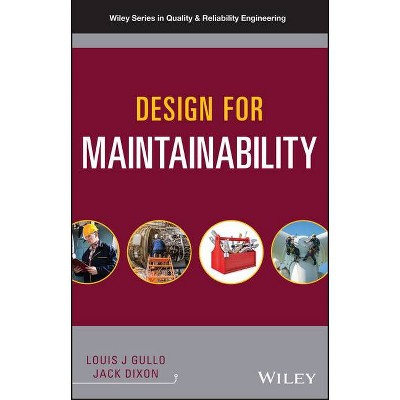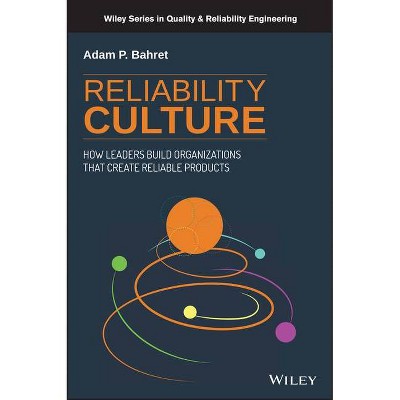Design for Maintainability - (Quality and Reliability Engineering) by Jack Dixon & Louis J Gullo (Hardcover)

Similar Products
Products of same category from the store
AllProduct info
<p/><br></br><p><b> About the Book </b></p></br></br>"Design for Maintainability" (DfMn) will provide design engineers, logistics engineers, and engineering managers with a range of tools and techniques for incorporating maintainability into the design process for complex systems. Our book will explain how to design for optimum maintenance capabilities and minimize the time to repair equipment. The book will cover maintainability design practices, which will result in improved system readiness, shorter downtimes, and substantial cost savings over the entire system life cycle, thereby, decreasing the Total Cost of Ownership (TCO). Readers who apply DfMn principles and practices can expect to have a dramatic improvement in their ability to compete in global markets and gain widespread customer satisfaction. Readers will find a wealth of design practices not covered in typical engineering books, allowing them to think outside the box when developing maintainability design requirements"--<p/><br></br><p><b> Book Synopsis </b></p></br></br><p><b>How to design for optimum maintenance capabilities and minimize the repair time</b> <p><i>Design for Maintainability</i> offers engineers a wide range of tools and techniques for incorporating maintainability into the design process for complex systems. With contributions from noted experts on the topic, the book explains how to design for optimum maintenance capabilities while simultaneously minimizing the time to repair equipment. <p>The book contains a wealth of examples and the most up-to-date maintainability design practices that have proven to result in better system readiness, shorter downtimes, and substantial cost savings over the entire system life cycle, thereby, decreasing the Total Cost of Ownership. Design for Maintainability offers a wealth of design practices not covered in typical engineering books, thus allowing readers to think outside the box when developing maintainability design requirements. The bookÂs principles and practices can help engineers to dramatically improve their ability to compete in global markets and gain widespread customer satisfaction. This important book: <li>Offers a complete overview of maintainability engineering as a system engineering discipline <li>Includes contributions from authors who are recognized leaders in the field <li>Contains real-life design examples, both good and bad, from various industries <li>Presents realistic illustrations of good maintainability design principles <li>Provides discussion of the interrelationships between maintainability with other related disciplines <li>Explores trending topics in technologies <p>Written for design and logistics engineers and managers, <i>Design for Maintainability</i> is a comprehensive resource containing the most reliable and innovative techniques for improving maintainability when designing a system or product.<p/><br></br><p><b> From the Back Cover </b></p></br></br><p><b>How to design for optimum maintenance capabilities and minimize the repair time</b> <p><i>Design for Maintainability</i> offers engineers a wide range of tools and techniques for incorporating maintainability into the design process for complex systems. With contributions from noted experts on the topic, the book explains how to design for optimum maintenance capabilities while simultaneously minimizing the time to repair equipment. <p>The book contains a wealth of examples and the most up-to-date maintainability design practices that have proven to result in better system readiness, shorter downtimes, and substantial cost savings over the entire system life cycle, thereby decreasing the Total Cost of Ownership. <i>Design for Maintainability</i> offers a wealth of design practices not covered in typical engineering books, thus allowing readers to think outside the box when developing maintainability design requirements. The book's principles and practices can help engineers to dramatically improve their ability to compete in global markets and gain widespread customer satisfaction. This important book <ul> <li>Offers a complete overview of maintainability engineering as a system engineering discipline</li> <li>Includes contributions from authors who are recognized leaders in the field</li> <li>Contains real-life design examples, both good and bad, from various industries</li> <li>Presents realistic illustrations of good maintainability design principles</li> <li>Provides discussion of the interrelationships between maintainability with other related disciplines</li> <li>Explores trending topics in technologies</li> </ul> <p>Written for design and logistic engineers and managers, <i>Design for Maintainability</i> is a comprehensive resource of the most reliable techniques for creating maintainability when designing a product.<p/><br></br><p><b> About the Author </b></p></br></br><p><b>Louis J. Gullo, </b> Electrical Engineer with over 35 years of leadership and hands-on experience in electronic systems, advanced technology research, reliability requirements, and engineering hardware and software development. Louis is retired from the US Army and Raytheon, an IEEE Senior Member, IEEE Reliability Society Standards Committee chair, currently employed at Northrop Grumman Corporation (NGC), Roy, UT. He is the co-editor/author of Design for Reliability and Design for Safety, both from Wiley. <p><b>Jack Dixon</b> is a Systems Engineering Consultant and President of JAMAR International, Inc. He has worked in the defense industry for over forty years doing system safety, human factors engineering, logistics support, systems engineering, program management, and business development. He is a contributing author of Design for Reliability and the co-author Design for Safety, both from Wiley.
Price History
Price Archive shows prices from various stores, lets you see history and find the cheapest. There is no actual sale on the website. For all support, inquiry and suggestion messagescommunication@pricearchive.us




















